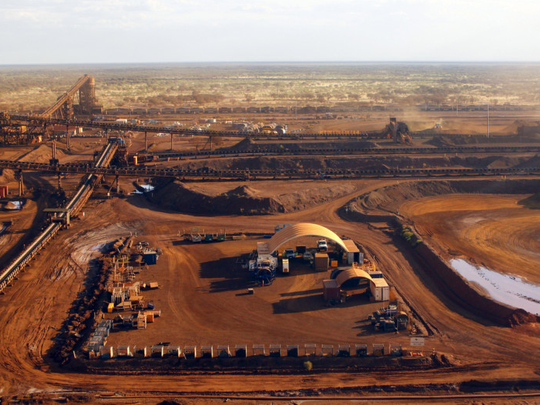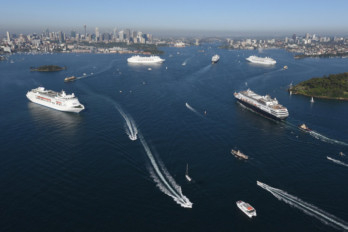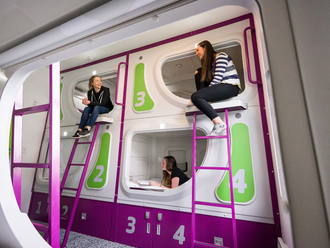
While there are a few clouds on the horizon dimming the outlook for economic growth in Australia this year, overall prospects remain good, economists and analysts say.
The Australian economy took a hit from slumping iron ore prices last year as growth slowed in China, the world’s largest consumer. The spot price hit a five-year low of $38.30 (Dh141) a tonne on December 11.
As a consequence, the government trimmed its growth forecasts for the second time in a year in mid-December and warned of a larger budget deficit than previously expected in the fiscal year to June 2016.
“Overshadowing Australia’s outlook are global commodity prices, which are inextricably linked to demand from China,” Robert Hill, Economist at Focus Economics, tells GN Focus. “The Mid-Year Economic and Fiscal Outlook revision surely took the effects from China’s slowdown into account.”
The government now expects the economy to expand at a rate of 2.5 per cent in fiscal 2016, less than the 2.75 per cent forecast in May. The budget deficit will be A$37.4 billion (about Dh97.3 billion) this fiscal year, up from A$35.1 billion.
In May 2015, iron ore price assumptions stood at $48 per tonne. The continued decline to below $40 per tonne has wiped A$7 billion off expected tax receipts this fiscal year. The government now predicts that it won’t return to a fiscal surplus until the fiscal year ending June 2021.
Nevertheless, it’s not all doom and gloom. The country has “strong public policy settings, economic resilience, and significant monetary and fiscal policy flexibility”, said analysts at financial services company Standard & Poor’s (S&P) in an August report. “We believe these factors enable Australia to absorb large economic and financial shocks as was demonstrated during the global recession in 2009.”
Despite falling tax receipts and difficulties in getting budget cuts through parliament, the government remains committed to reining in spending, and funding any new initiatives by spending less on others.
And while iron ore prices have slumped, export volumes have not.
“Australia has recently expanded its iron production capacity and is able to produce iron, and other resources, at a relatively low costs,” Hill explains. “This has allowed the country the opportunity to capture more of the global market share for iron. This should prolong the lifespan of low-cost mining operations in Australia, and provide some back-up for the transitioning economy.”
He adds that, for now, the declining importance of the mining sector “will likely not be drastic enough to jeopardise Australia’s AAA credit rating”.
S&P agrees that strong demand for Australian commodities persists. “Commodity export volumes are rising strongly as mining and energy projects come on line, supporting the country’s economic performance,” said the research note. “The completion of some very large liquefied natural gas projects and resulting jump in related exports should spur economic growth in the next couple of years.”
Burgeoning sectors
Other segments of Australia’s economy are performing well — especially the services sector, led by tourism and education, which are being helped by a weaker Australian dollar and robust demand from burgeoning middle classes in Asia.
Indeed, 2014-15 was the first time in six years that service exports contributed more to growth than iron ore exports, according to the Reserve Bank of Australia.
“Over the past year, education exports were Australia’s third-largest export earner, at around A$18 billion, behind only iron ore and coal,” Paul Bloxham, Chief Australia and New Zealand Economist at HSBC Bank, wrote in a September research note. “Indeed, over the past couple of years, services exports have shifted from being a net drag on GDP growth to being a net contributor and have contributed more to GDP than resources exports over the past year.”
Annual visitor arrivals from China have more than doubled over the past five years, from 400,000 to 940,000, according to the Australian Bureau of Statistics.
In the year to October — the most recent month for which data is available — Chinese international student enrolments increased at a rate of 9.4 per cent compared to the same period a year ago, according to government statistics.
Adding to initiatives to rebalance the economy, Prime Minister Malcolm Turnbull in early December unveiled his $1.1-billion National Innovation and Science Agenda designed to “create a modern, dynamic, 21st century economy for Australia”.
Boosting measures
This agenda includes a new type of visa for entrepreneurs, tax incentives for start-up investors and changes to bankruptcy laws.
“These measures should work to diversify the economy in the future, and help to pivot away from resource-intensive growth,” says Hill, although he points out that at this early stage it is difficult to quantify exactly what impact this agenda will have on growth, or on economic diversification.
“Critics point out that this agenda is too little too late, in the sense that it is long overdue and does little more than to help Australia catch up with the rest of the world, as opposed to making it a global leader in research and development,” he adds.
“Nonetheless, the new prime minister has signalled that he is aware of Australia’s shortcomings in this field and is taking the initiative, particularly in comparison to his predecessor, who pushed ahead with expansions in the mining sector as late as mid-year 2015.”






